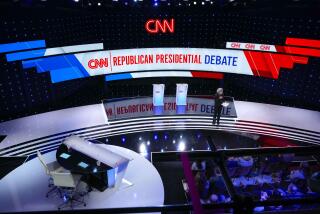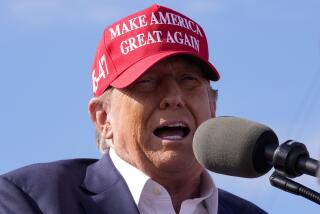Wide-Open Races Show Cracks in Fund System
- Share via
With no incumbent running, the presidency is wide open for the first time in 20 years. And the competition for nomination in both parties is costing about 50% more than in 1984, when there was no Republican challenge to President Reagan’s renomination.
Inflation and entitlements for eligible candidates and parties are eating up at a rapid rate the balances of the Presidential Election Campaign Fund, supplied by income-tax check-offs. America’s system of public funding that has served four presidential election cycles may soon be in jeopardy.
Unfortunately, no quick fix is in sight. Efforts to extend public funding to Senate campaigns have diverted attention from the fine-tuning that was desirable in the laws governing presidential campaigns. While the costs and problems this year may spur increased public concern, congressional action in an election year is very unlikely.
Still, the campaign for votes in the Super Tuesday primaries illustrates the problem that presidential candidates are facing. Super Tuesday was almost half a national primary--20 states for the Democrats and 17 for the Republicans. But even with such a crucial test the candidates had to be selective in marshaling and allocating their resources. If the campaigns remain competitive through the California primary on June 7 or up to the time of the conventions, the leading spenders will come perilously close to exceeding the overall spending limit that the law imposes--$27.7 million per candidate. Republican candidate Pat Robertson is already close to that point, which will leave him little freedom of action if he decides to accept public funds.
But not even Robertson or the other big GOP fund-raisers--George Bush and Bob Dole--could afford to spend the $5-million minimum that most experts said was necessary in order to campaign effectively in the Super Tuesday states, or to purchase spot broadcast announcements in the 50 or more key media markets. They simply would be leaving themselves too short for the rest of the long presidential season.
Limits on how much a candidate can spend in each state also have become wholly unrealistic in this day of media-dominated, regional presidential campaigning. The limits force candidates to engage in subterfuges that make a mockery of the law and further confuse the funding picture.
Consider the psychological stake of winning in Iowa, where the spending limit was $775,000, or in New Hampshire, where the limit was $461,000. Candidates found ways to assign spending to their national headquarters or to surrounding states or to fund-raising costs, a separate accounting procedure. For example, autos were rented in Massachusetts for use in New Hampshire. The Federal Election Commission allowed for 80% of the television time purchased on Boston stations, reaching 80% of the New Hampshire population, to be allocated to the Massachusetts limit, where the primary would not be held until Super Tuesday. Richard Gephardt put tag-end requests for contributions on his television ads and allocated half the cost of the ads to fund-raising, and thus the expense was not credited against the New Hampshire limits. By sanctioning such allocations, the FEC allows the candidates to avoid exceeding the state limits. In any case, documented excessive spending brings only an FEC fine in the amount of the overspending, months after the event, and is considered by cynical candidates as a cost of “doing business.”
The ultimate absurdity of the state spending limits, however, can be found by adding them all up. For the 50 states this produces a total of $70 million, three times the $27.7-million national limit (including fund-raising costs) that a candidate can legally spend.
If the system of public funding of presidential campaigns is to survive, we must start thinking of making changes soon. The Presidential Election Campaign Fund will be sufficient for the 1988 elections. But there will be much less to carry over for 1992, and the amount that is raised by the tax check-off has been declining. At the same time, the cost of campaigning continues to rise.
While the individual contribution limit of $1,000 per candidate per election may seem high to many Americans who could not make such a gift, the erosion of the dollar has been so severe that a $1,000 contribution today is worth about $400 in 1975 values, when the limit went into effect.
Yet the costs of most items needed in campaigns have skyrocketed at a much higher rate. From 1984 to 1988 the cost of a 30-second commercial during a top-rated television show in Des Moines rose about 64%, from $1,100 to $1,800.
The experience so far this year raises serious questions about the adequacy of the amounts of public funding that the candidates are receiving in order to enable them to compete effectively. Increases in the rate of the tax check-off, in the amounts of the public funding and in the overall expenditure limits are both necessary and justified.
More to Read
Get the L.A. Times Politics newsletter
Deeply reported insights into legislation, politics and policy from Sacramento, Washington and beyond. In your inbox twice per week.
You may occasionally receive promotional content from the Los Angeles Times.










